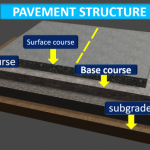Pavement engineering is a branch of civil engineering that uses engineering techniques to design and maintain flexible (asphalt) and rigid (concrete) pavements. This includes streets and highways and involves knowledge of soils, hydraulics, and material properties. Pavement engineering involves new construction as well as rehabilitation and maintenance of existing pavements. Maintenance often involves using engineering judgment to make maintenance repairs with the highest long-term benefit and lowest cost. The Pavement Condition Index (PCI) is an example of an engineering approach applied to existing pavements. Another example is the use of a falling weight deflectometer (FWD) to non-destructively test existing pavements. Calculation of pavement layer strengths can be performed from the resulting deflection data. The two methods – empirical or mechanistic is used to determine pavement layer thicknesses.
Types of Pavements
There are two types of pavements based on design considerations i.e.
· flexible pavement
· rigid pavement.
Difference between flexible and rigid pavements is based on the manner in which the loads are distributed to the subgrade. Before we differentiate between flexible pavements and rigid pavements, it is better to first know about them. Details of these two are presented below:
Flexible Pavements:
Flexible pavement can be defined as the one consisting of a mixture of asphaltic or bituminous material and aggregates placed on a bed of compacted granular material of appropriate quality in layers over the subgrade. Water bound macadam roads and stabilized soil roads with or without asphaltic toppings are examples of flexible pavements. The design of flexible pavement is based on the principle that for a load of any magnitude, the intensity of a load diminishes as the load is transmitted downwards from the surface by virtue of spreading over an increasingly larger area, by carrying it deep enough into the ground through successive layers of granular material.

Fig: Flexible Pavement Cross-section
Thus for flexible pavement, there can be grading in the quality of materials used, the materials with high degree of strength is used at or near the surface. Thus the strength of subgrade primarily influences the thickness of the flexible pavement.
Rigid Pavements:
A rigid pavement is constructed from cement concrete or reinforced concrete slabs. Grouted concrete roads are in the category of semi-rigid pavements. The design of rigid pavement is based on providing a structural cement concrete slab of sufficient strength to resists the loads from traffic. The rigid pavement has rigidity and high modulus of elasticity to distribute the load over a relatively wide area of soil.

Minor variations in subgrade strength have little influence on the structural capacity of a rigid pavement. In the design of a rigid pavement, the flexural strength of concrete is the major factor and not the strength of subgrade. Due to this property of pavement, when the subgrade deflects beneath the rigid pavement, the concrete slab is able to bridge over the localized failures and areas of inadequate support from subgrade because of slab action.
Difference between Flexible Pavements and Rigid Pavements
| Sl. No. | Flexible Pavement | Rigid Pavement |
| 1. | It consists of a series of layers with the highest quality materials at or near the surface of pavement. | It consists of one layer Portland cement concrete slab or relatively high flexural strength. |
| 2. | It reflects the deformations of subgrade and subsequent layers on the surface. | It is able to bridge over localized failures and area of inadequate support. |
| 3. | Its stability depends upon the aggregate interlock, particle friction and cohesion. | Its structural strength is provided by the pavement slab itself by its beam action. |
| 4. | Pavement design is greatly influenced by the subgrade strength. | Flexural strength of concrete is a major factor for design. |
| 5. | It functions by a way of load distribution through the component layers | It distributes load over a wide area of subgrade because of its rigidity and high modulus of elasticity. |
| 6. | Temperature variations due to change in atmospheric conditions do not produce stresses in flexible pavements. | Temperature changes induce heavy stresses in rigid pavements. |
| 7. | Flexible pavements have self healing properties due to heavier wheel loads are recoverable due to some extent. | Any excessive deformations occurring due to heavier wheel loads are not recoverable, i.e. settlements are permanent. |


